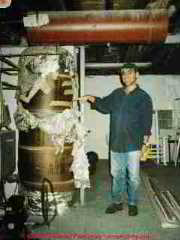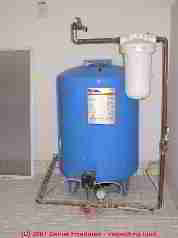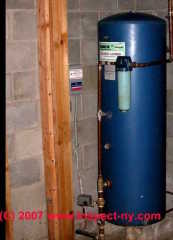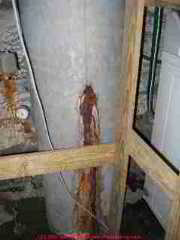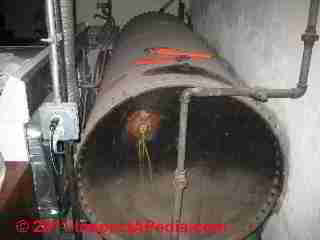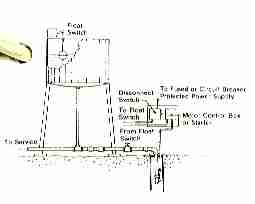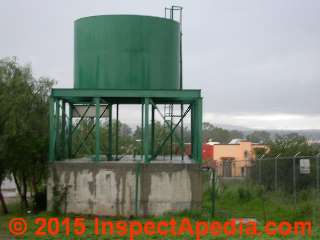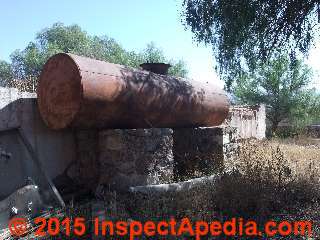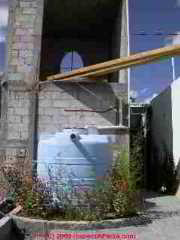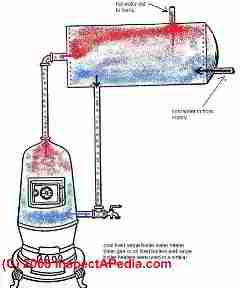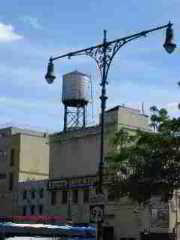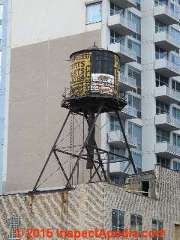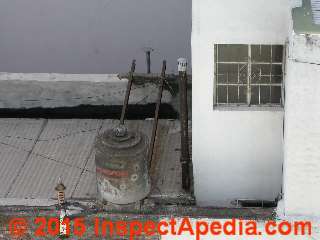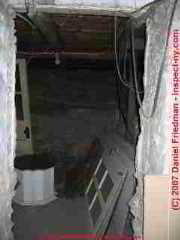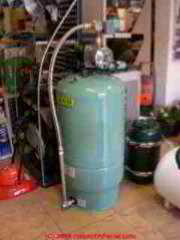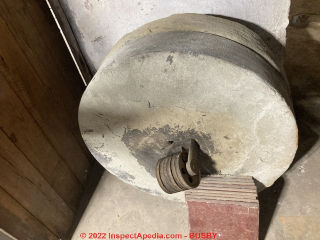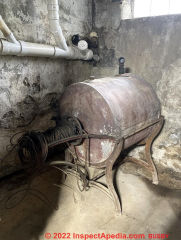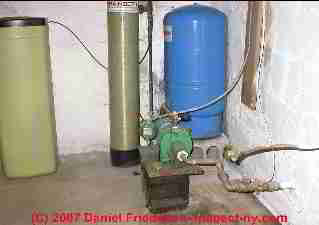 Types of Tanks Found in Buildings
Types of Tanks Found in Buildings
How to Find & Identify
Expansion Tanks, Oil Tanks, Range Boilers, Water Softener Tanks, Water Pressure Tanks, Water Heater Tanks
- POST a QUESTION or COMMENT about the various types of tanks found in buildings: water tanks of all types as well as other tanks
Guide to identifying the types of tanks & water tanks found in or at buildings:
This article describes water tanks and other kinds of storage tanks found in buildings, captive air and traditional water storage tanks or water pressure tanks, and we provide advice about what to do when things go wrong, such as finding air and water leaks or deciding to replace a water tank.
Water storage tanks, cisterns, rooftop tanks, open tanks, water pressure tanks, steel tanks, range boilers, indirect-fired water heatersExpansion tanks in attics & basements, oil storage tanks, other tanks in attics, basements, etc.; water heater tanks, cisterns, oil tanks, others.
InspectAPedia tolerates no conflicts of interest. We have no relationship with advertisers, products, or services discussed at this website.
- Daniel Friedman, Publisher/Editor/Author - See WHO ARE WE?
Types & Uses of Residential & Light Commercial Water Tanks & Other Liquid Storage Tanks
Various types of tanks uses in and around buildings are identified and explained below, including water pressure tanks, water storage tanks, range boilers for hot water, indirect fired hot water tanks, expansion tanks in attics, basements, and on heating boilers, oil storage tanks, rooftop tanks, cisterns, water pressure booster systems.We also discuss when to replace water tanks.
[Click to enarge any image]
Article Series Contents
- AMTROL's EXTROL®, the FILL-TROL® - separate article
- ATTIC EXPANSION TANKS for Heating Boilers
- ATTIC & ANTIQUE EXPANSION TANKS, HEATING - separate article
- BASEMENT EXPANSION TANKS for Heating Boilers
- BLADDERLES FIBERGLASS WATER TANKS
- BLADDERLESS STEEL WATER Storage/Pressure Tanks
- CAPTIVE AIR TANKS bladder-type water tanks for Building Water Pressure Regulation
- CISTERNS for Water Storage
- EXPANSION TANKS, HEATING - separate article
- HOT WATER EXPANSION TANKS - separate article
- HOT WATER TANKS, RANGE BOILERS - separate article
- HOT WATER TANKS, INDIRECT FIRED - separate article
- INDIRECT HOT WATER TANKS - separate article
- LARGE CAPACITY WATER STORAGE TANKS - separate article
- NO-TANK CONSTANT PRESSURE SYSTEMS
- OIL STORAGE TANKS - separate article
- OPEN WATER TANKS, Indoors - separate article
- GRAVITY OPERATED WATER TANKS & Open Water Tanks Indoors
- PLASTIC RECYCLING CODES, TANKS, TYPES - separate article
- PLASTIC & FIBERGLASS WATER STORAGE TANKS - HDPE Tanks
- RAINWATER STORAGE TANKS - separate article
- RANGE BOILERS - separate article
- RANGE BOILERS for Domestic Hot Water Systems
- REPLACEMENT WATER TANKS - separate article
- REVERSE OSMOSIS WATER TREATMENT TANKS
- ROOFTOP WATER TANKS - separate article
- ROOFTOP WATER TANKS or FREE-STANDING WATER TOWERS
- SEPTIC TANKS - home - separate article series
- STEEL WATER TANKS - separate article
- WATER PRESSURE BOOSTING PUMPS - separate article
- WATER PRESSURE BOOSTER SYSTEMS
- WATER PRESSURE TANKS, BLADDER TYPE
- WATER PRESSURE TANKS, FIBERGLASS - separate article
- WATER PRESSURE TANKS, STEEL - separate article
- WATER PUMP VARIABLE FREQUENCY / VARIABLE SPEED DRIVE (VFDs) - tankless systems
- WATER SOFTENER TANKS
- WATER STORAGE TANKS, GROUND LEVEL - separate article
- WATER STORAGE TANKS, LARGE - separate article
- WATER STORAGE TANKS, OPEN
- WATER STORAGE TANKS, ROOFTOP - separate article
- WATER TANK: USES, TROUBLESHOOTING - separate article: types of water storage & water pressure tanks
- WATER TREATMENT SYSTEM TANKS
- WATER TANK REPLACEMENT - WHEN?
Captive Air - Internal-bladder-type water tanks for Building Water Pressure Regulation
Newer "captive air" tanks use a rubber or other membrane material as a bladder to keep water and air separate.
Usually tanks that use an internal bladder are constructed of painted steel like the blue water tank shown in our photo.
This prevents the air charge from being absorbed into the water, so you should never need to add air to those systems.
At WATER PRESSURE TANKS, BLADDER TYPE we discuss this type of water tank in detail.
At WATER TANKS HOW THEY WORK we provide details of how water pressure tanks work.
Loss of air in "captive air" bladder type water pressure or water storage tanks
If a "captive air" or internal "bladder" (usually rubber) type tank is installed, and if the pump is short-cycling on and off, you should turn off the pump and call a plumber.
We would suspect that the bladder has ruptured, or that the tank itself has developed a leak.
We explain waterlogged water tanks and water pump short cycling in detail at WATER TANK REPAIRS where we also explain in detail what well pump short cycling is - how to diagnose captive-air type water tank problems and how to correct these conditions by repairing or replacing the water tank bladder or the tank itself.
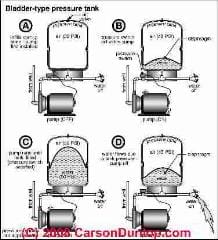 Regardless, short cycling of the well pump would damage the
pump or pump controls.
Regardless, short cycling of the well pump would damage the
pump or pump controls.
These tanks are made of steel or fiberglass, and typically have an air schrader valve at the top of the tank.The air valve is used for adjustment of the air pressure in the tank at the time of initial installation.Normally you never need to add air to these tanks after initial installation.
Sketch courtesy of Carson Dunlop Associates, a Toronto home inspection, education & report writing tool company [ carsondunlop.com ].
The newer type "captive air" tanks, one which use an internal bladder to contain the water separately from the air charge, can also fail.The bladder can rupture as we discussed above - you need a new tank.
The tank itself can develop an air leak - you need a new tank.But these failures occur less often than with the older single chamber steel water pressure tank, largely because the tank bladder holding the water supply protects the tank interior from corrosion.
On some captive air water tanks this design is reversed.
For example on the WellMate™ water tank the water is in the tank and air is in the tank bladder.This difference can confuse the burst water tank bladder diagnosis procedure which we describe below.
At WellMate WATER PRESSURE TANK we provide separate water tank diagnosis and repair advice for captive-air water tanks in which the air is in the bladder and the water is outside the bladder in the water tank.
See these detailed articles on bladder-type "captive air" water tank diagnosis and repair:
WATER TANK BLADDERS & CAPTIVE AIR - how water pressure tanks work, the difference between internal bladder type and bladderless wat4er tanks, causes of bladder type water tank failures.
WATER TANK BLADDER PRESSURE ADJUSTMENT how to adjust bladder type water tank pressures or air pre-charge
Also see WATER PUMP & TANK I&O & REPAIR MANUALS
Bladderless Fiberglass Water Tanks
Bladderless Fiberglass Water Pressure Tanks, such as the WellMate traditional hydro-pneumatic water tank operate similar to the steel water pressure tank, that is, no internal bladder is used to maintain and separate the tank's air charge and water charge pressure.
These tanks incorporate a tank-top mounted air volume control and offer the advantage (over steel water tanks) of no risk of rust perforation and leak at the water tank.
At WellMate Diagnosis we provide separate water tank diagnosis and repair advice for this water tank type.
Bladder-less Traditional Steel Water Pressure & Water Storage Tanks
There may be lots of kinds of tanks found in buildings, storing water, fuel, hot water, or serving other purposes.
We review quite a few of them here and include photographs to help you figure out what's what.
Steel,Bladderless Water Storage/Pressure Tanks
In our two water pressure tank photos above we show that steel water pressure tanks may be painted or may be galvanized steel.These water tanks may also be glass lined or epoxy coated for durability.
Traditional bladderless steel water pressure tanks like the two shown here do NOT use an internal bladder to keep water and the tank air charge separate.
Details about steel water pressure tanks & steel water storage tanks are found
and
at LARGE CAPACITY WATER STORAGE TANKFrom varioius causes including leaks (photo above) these tanks can lose their air charge, resulting in pump short cycling and pulsating water pressure described separately
Attic Expansion Tanks for Heating Boilers & Other Storage Tanks Found in Attics
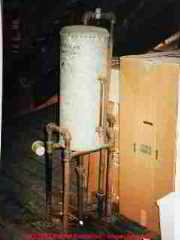
Attic expansion tanks and pressure relief systems for boilers: Don't confuse an old heating system attic-mounted expansion tank like the one shown here for a water tank storage tank or a range boiler.
The heating system expansion tank will be connected to the heating system radiators or basement boiler and may have a simple overflow pipe to permit excessive water (or system pressure) to spill outside.
Systems which rely on a remote attic-mounted expansion tank are less safe since than a boiler that has a pressure and temperature relief valve mounted right on or at the boiler.
See ATTIC & ANTIQUE EXPANSION TANKS, HEATING for details about this device.
Basement Expansion Tanks for Heating Boilers & Other Tanks found in Basements
Our client is pointing to a do-it-yourself insulating job on a water heater.But that reddish-brown horizontal tank over his head is an expansion tank for the hydronic heating boiler in this building.
This is not a water storage tank, it's not a range boiler, it's an expansion tank.
This basement expansion tank is expected to be on a heating boiler that also has a pressure and temperature relief valve.
See EXPANSION TANKS for details about expansion tanks and pressure tanks used on heating systems.
Also see RANGE BOILERS
and CISTERNS, WATER STORAGE and of course
Indirect-Fired Domestic Hot Water Tanks
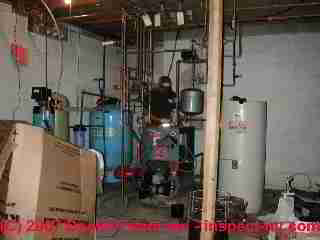
Indirect fired water heaters: In some other buildings domestic hot water is produced by cycling hot water from a hydronic or steam boiler through a loop inside of a steel tank.The water in the tank is heated by the water in the coil.
Modern systems
using this approach use the term indirect-fired water heater and such systems are sold by various companies
such as the SuperStorTM unit shown here as the white tank to the right of the heating boiler.
Indirect fired water heater tanks for domestic hot water, such as the SuperStorTM are usually located close to the heating boiler and will have both cold and hot water lines leaving the tank to supply the
building with domestic hot water and a loop of piping that runs between the [usually the] bottom of the tank and a nearby heating boiler.
Follow the pipes to see which pipes are performing which function.
The range boiler is an old concept in use for about 100 years.Indirect fired water heaters are a modern system and are in current sales and use.
See HOT WATER TANKS, INDIRECT FIRED for details about this type of water heater.
See WATER HEATERS for details about residential hot water systems.
LARGE WATER TANKS - Large Water Storage Tanks, Why They Are Used, What They Imply about Well Recovery Rate or Well Yield
Details about the use of large water storage tanks to handle low-flow wells or limited municipal water supply are provided
at WATER STORAGE TANKS, LARGE.Excerpts are below.
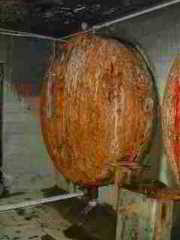
As we explain in that article, large water storage tanks, such as the one whose end is visible in our photo (above) usually mean that the well flow rate is very slow, even inadequate by contemporary standards.
This was one of a pair of very large, buried water storage tanks at a large private home in New York.
The well flow rate must have been miniscule and the water usage rate high to require such large onsite water storage at a private home or estate.The life expectancy or future usability of the well must be questioned.
A similar, large water storage & pressure tank is shown just above.This tank, located indoors in a utility area, was fully visible but no longer functioning.
We explain how people determine the necessary water tank size and volume
No-Tank Water Delivery Systems
 There are several systems that dispense with any on-site water pressure regulating tank and also with onsite water storage tanks.
There are several systems that dispense with any on-site water pressure regulating tank and also with onsite water storage tanks.
These tankless or "no-tank" water delivery systems are suitable for locations where the well flow rate capacity is meets or exceeds the needs of the building, property, or users, or where a constant-pressure water supply pump is being used on a municipal water supply system.
Illustration: A Simer tankless water pump, discussed at WATER PUMP PRESSURE SENSTIVE - live link given below.[Click to enlarge any image]
- In-Well Technologies NO-TANK INSTALLATION INSTRUCTIONS [PDF], In-Well Technologies Inc., 7391 Porcupine Lake Rd., Lena WI 54139 USA, Tel: 920-829-5690, Email: infor@inwelltech.com Website: inwelltech.com retrieved 2018/06/22, original source: http://www.inwelltech.com/install.html
Website excerpt: ...The "No Tank" water pressure tank was designed to be installed directly into a 4, 5, or 6 inch well casing or larger, replacing conventional style tank installations.
This system makes use of a small-diameter pressure-regulating "no-tank" inserted into the well casing near the well top.This in-well tank uses an air pre-charge.
An accompanying pressure-transducer that controls the well pump operation is installed at the well or in the building.The "No-Tank" is designed to work with a constant pressure variable speed water pump. - WATER PRESSURE BOOSTER PUMP - This article describes the use of water pressure boosting systems that add a pump and pressure tank to improve water pressure and flow, including improving water pressure & flow on the upper floors of tall buildings.
- WATER PUMP PRESSURE SENSITIVE - Pressure sensitive pumps and inline pump controllers can provide water pressure boosting, rainwater harvesting, or similar functions without requiring a water pressure tank.
This article also answers: What are pressure sensitive pumps and what are inline pump controls, how do they work and where are they most often used?
Oil Storage Tanks in Buildings
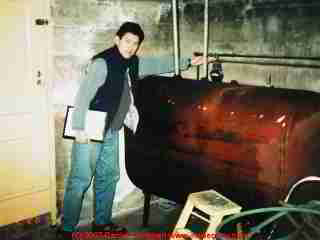
This is a typical indoor oil storage tank in a residential building.We have a lot to say about oil tanks in buildings, oil tank leaks, environmental risks, potential costly cleanups, and effects of oil tank problems on the heating system and its operation.
For information about oil tank issues and solutions see OIL TANKS - Heating Oil Underground & Above ground Oil Storage Tank Leaks, Testing, Problems & Solutions, Home Buyer's / Home Owner's Guide.These online articles answer most questions about above ground or buried oil storage tanks.
Watch out: What's really important in this indoor oil storage tank photo is the black wall-mounted gauge our client is pointing to.He's found an indication that there is or was a buried underground oil tank at this property - potentially a costly environmental problem if that tank leaked.
Given the leakage all over the old oil tank that we can see indoors in this photo, we weren't too optimistic about what might have happened with an old outdoor buried tank.Some testing was ordered.
OPEN WATER TANKS - gravity fed water systems or pump-up rooftop systems with and without pressure-boosting pumps and water tanks
Free-standing Water Tanks at Ground Level
Above is a sketch of the piping for a traditional above-ground water tank used to accumulate and store a supply of water.
Below is a water tower at Atascadero, in San Miguel de Allende, Guanajuato, Mexico.
This green water tank is atop a hill serving the community of Atascadero.It is mounted atop an older concrete tank/cistern at the same location.
Above is a large above-ground water storage tank at Gogorron in San Luis Potosi, Mexico.
Rooftop water tanks in urban areas such as New York City may be used to supply water at high pressure to the building below.
These water tanks are smaller versions of the (usually) much larger free-standing water storage tanks and are used to supply water at pressure to the building floors below or are used to supply emergency water to a building fire suppression system.
Water is pumped to the rooftop tank from its municipal source, then redistributed at good pressure to the points of use in the building below.When passing through New York City, look at rooftops and you'll often see these tanks still in use.
This sketch shows how a rooftop tank might be constructed, though this particular sketch has the tank next to a well.
See details at CISTERNS, WATER STORAGE.
Plastic & Fiberglass Water Storage Tanks - HDPE Tanks
Reader Herman Voegel has pointed out that an up-and-coming area of storage containers includes spun-plastic tanks.
Specifically, new storage tank types include High Density Polyethylene (HDPE), currently available as tank storage for water, chemicals, waste oils, etc..General HDPE containers come in all shapes and sizes and are quite rugged and relatively cheap compared to using typical 12-gauge steel home heating oil tanks.
The ruggedness of HDPE plastic containers comes from their material density which is typically at a minimum specific-gravity of 1.7, and for heavy-duty at 1.9.
Home heating oil has not yet been approved for storage in HDPE tanks, basically for two reasons:
- UV (ultra-violet) light degrading HDPE plastics over time, making them weak, and
- Problems with slight permeation seepage through their plastic walls.
However, fixes have been put in place to properly address these problems.UV-light is checked by using special color additives that prevent their light from penetrating and degrading the plastic walls.Permeation or seepage of oil through container walls is checked by coating them with fiberglass.
Unfortunately, even with these fixes, HDPE plastics for heating oil storage have yet to be universally approved and accepted.
Readers should also
see PLASTIC RECYCLING CODES, TANKS, TYPES where we describe health and other concerns involving plastic tanks and other containers used for water storage.
Range Boilers for Domestic Hot Water Systems
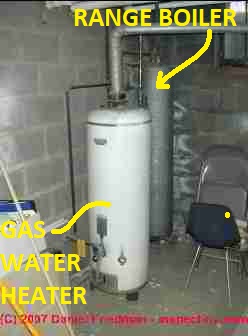
Range boilers are vertical or horizontal hot water systems whose water is heated by circulating the water from within a water storage tank (the range boiler) through a heat exchanger which is inside or connected to the exterior of a heating boiler.
The water in the hot water tank range boiler is heated by circulating its water through the heat exchanger which itself is heated by the water inside or from the heating boiler.
The sketch illustrates how a very early type of coal-fired water heater range boiler worked.
As homeowners shifted fuels from coal to oil or gas and installed central heating boilers, often the range boiler water heater was adapted to work with these systems as well, as you can see in the photograph.
As with the indirect-fired boiler described next, range boiler water heating tanks are usually located close to the heating boiler and will have both cold and hot water lines leaving the tank to supply the building with domestic hot water and a loop of piping that runs between the bottom of the hot water tank and a nearby heating boiler.
Follow the pipes to see which pipes are performing which function.
Our photo above shows a silver steel range boiler hiding back in the corner behind the newer (though pretty old) gas fired water heater.
Notice also the efflorescence on the masonry block foundation, where the downspout has been spilling by the house foundation?
See HOT WATER TANKS, RANGE BOILERS for details about range boiler water heaters.
See WATER HEATERS for details about residential hot water systems
What's the difference between a range boiler, an indirect fired water heater, and an expansion tank?
The range boiler is an old concept in use for about 100 years.
Details are at HOT WATER TANKS, RANGE BOILERS
A similar concept is found at indirect fired water heaters, a modern system and are in current sales and use.
But indirect water heaters use a circulator pump to cycle heating boiler water between the boiler and a separate hot water tank.Inside the hot water tank a coil containing boiler water heats the physically separate domestic hot water in the tank.
See details at HOT WATER TANKS, INDIRECT FIRED
Also see EXPANSION TANKS for a guide to smaller tanks used to absorb pressure increases on hot water heating systems.
Reverse Osmosis (RO) water treatment tanks
Reverse osmosis tanks are generally small in size and located as centralized treatment equipment or more often as a point of use under-sink water treatment unit.
Details about RO systems are at
Rooftop Water Storage Systems
Details about rooftop water systems, tanks, and booster pumps are at
ROOFTOP WATER TANKS. Excerpts are below:
Rooftop water storage tanks are used to provide water at functional pressure in tall buildings, to provide water for building fire sprinkler systems.
Shown above, a rooftop water tank in New York City.Below is a traditional wood rooftop water tank in Chicago.
In some areas, Mexico, for example, rooftop water reservoirs are supplied intermittently with water from a water main in the street.In that case the building water supply is fed from its rooftop water tank and the tank is replenished intermittently when the municipal water supply is able to send water to its constituents.
The rooftop water storage tank shown just below is made of concrete and is installed atop a building in Buenos Aires.
See details at ROOFTOP WATER TANKS
and also see CISTERNS, WATER STORAGE.
We discuss water pressure booster pump and tank systems in detail
at PUMP, WATER PRESSURE BOOSTING
Open Water Tanks Indoors

At some locations there is an up-hill or rooftop water source which is fed into the building entirely by gravity.The open top water tank in these photos used a simple float valve to let water into this storage tank.
See details at CISTERNS, WATER STORAGE.
Cisterns for Water Storage
Basement & Outdoor Cisterns, are often located in the basement or courtyard of buildings where they collect rainwater for future use.In the U.S.cisterns were often located in the basement of a (pre-1900) home.This cistern was originally filled by downspouts directing roof runoff into the basement.
Details about cisterns are found at CISTERNS, WATER STORAGE.
Rainwater Storage Tanks & Cisterns
In arid areas such as the U.S.Southwest and parts of Mexico, very large cisterns are often placed in a courtyard where they collect rainwater for use during the dry season.
The above-ground water cistern storage tank shown in our photo is located in Mexico and is discussed
at PASSIVE SOLAR HOME, LOW COST.
Rainwater for this cistern is collected from a near-flat rooftop [photo] and channeled to a large fiberglass holding tank - the blue tank in our photograph, (above left).
Piping also permits directing water into this tank from a well-fed cistern located atop the concrete block tower [photo]).
See rainwater collection and storage cistern details at CISTERNS, WATER STORAGE.
Water Pressure Boosting Systems
Water pressure booster pumps and tanks may be installed in buildings where municipal water is supplied, at a cistern water supply, and to boost the water pressure in buildings where a water tank is located on rooftops or anywhere in a building.
Just because you see a pump and pressure tank, don't assume that the building is served by a private well.
Water pressure boosting systems using a water pump and water tank are installed
in homes where the municipal water supply or cistern or water storage tank supply pressure is low.
We discuss water pressure booster pump and tank systems in detail
at PUMP, WATER PRESSURE BOOSTING
See WATER PRESSURE LOSS DIAGNOSIS & REPAIR for details on how to correct low water pressure in a building.
Water Softener Tanks
Water softeners use one or a pair of tanks to treat water for hardness and to contain salt or a similar compound.
Details are at WATER SOFTENERS & CONDITIONERS
Water Treatment Equipment Tanks
We have listed reverse osmosis treatment and water softeners as examples of uses of tanks in buildings.But there is a wider variety of water treatment equipment, some of which also uses tanks, such as treatment of water for odors, water chlorinators, etc.Details are
at WATER TREATMENT EQUIPMENT CHOICES
When do you need a new water tank?
Details about when to replace a damaged water pressure tank or water storage tank and also about where to locate the water tank are
at WATER TANK LIFE & REPLACEMENT.Excerpts are below.

When an older type (non-captive-air) tank needs replacement (for example because it has rusted through and has perforations leaking water or air, or if adding air frequently becomes a hassle, you'll want the newer type of "captive air" or "bladder" tank.
If your water storage tank looks like this one, or if you see a "pinhole" leak, it may be possible to make a temporary emergency repair using a rubber washer and screw, as we describe at
But you need a new water tank.
...
Reader Comments, Questions & Answers About The Article Above
Below you will find questions and answers previously posted on this page at its page bottom reader comment box.
Reader Q&A - also see RECOMMENDED ARTICLES & FAQs
On 2022-08-10 by InspectApedia (mod) - what was the use of this old tank?
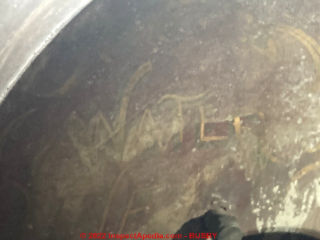 @Richard Busby,
@Richard Busby,
From the fittings, that looks like a fuel storage tank, or perhaps from your notes a small water tank, or re-purposed as a water tank - and a rather old one.
Your other photos show what appears to be a chain-driven spool or as you put it, a winch that wound a cable - typically for lifting something, though among your other photos as well is what looks like a grinding or sharpening wheel and more chain-driven sprockets.
The power source that rotated the winch cable could have been a weight over pulleys, lifting water or something else, but those round stones sure looked like a grindstone.
The tank is too small to have been very useful for water storage but could, if it actually contained water, not fuel, an early water pressure tank intended to work with a water pump system.
Let's see what else can be suggested by other readers; we'll keep your photo on this page and perhaps add a couple of your others for discussion.
Below I attach a copy of your image, rotated and cropped.
I don't see an obvious connection between the storage tank and the cable spool but it's interesting to note that the stand for the tank also supports the cable and winch assembly.
Indeed water could have been stored in this tank, not fuel, though its size
Adding your images here
...
On 2022-08-10 by Richard Busby - what is this tank found in the cellar of an 1840s house?
What is this tank? This was found in the cellar of an 1840s house that formerly had two cisterns.
The owners tell me that the winch on the end was attached to a stone weight, by cable.The stone was held up by a series of free spinning pulleys suspended from the joists above the tank when they found it.
The winch was connected by chain to a gear extended through the foundation wall.Any ideas?
The only marking found are the words "Water Line" painted in fancy script.I have more images of the tank and components (including the stone weight mentioned) stored in this google folder:
[Link deleted by mod]
Thanks! I'd like to hear what you make of it (richarddbusby@gmail.com)
On 2021-03-27 by danjoefriedman (mod) - most very large water tanks don't use an internal bladder. How to set the air charge.
@Ken, there are plenty of large water storage tanks in use, though at that size, usually without an internal bladder;
Set the empty water tank's air pre-charge to 2 psi below the pressure control switch CUT IN pressure.
On 2021-03-27 by Ken
How can we use a large ~ 400 gallon tank that has an internal bladder for a water reservoir.
Our pump is a demand type pump and there is a small ~30 gallon bladder type tank also.With the air pressure in the large tank, it does not appear to have much water in it.
I'm thinking if I lower the air pressure we will get more storage capacity from the tank.
On 2020-06-25 by danjoefriedman (mod) - I need to check the water tank bladder pressure
Mike
Yes that is exactly correct but you can also simply install a normal water pressure gauge on the system and see what the tank pressure is when all water has been drained from the tank.
We show using a conventional tire pressure gauge to measure water tank air pressure
at WATER TANK AIR ADD AT AIR VALVE
and
at WATER PRESSURE GAUGE ACCURACY
See
On 2020-06-21 by mike
I want to check air pressure in my blatter.
I need a air pressure gagure not a water pressure gague.
correct?
On 2017-02-01 by danjoefriedman (mod) - water pressure booster pump for rooftop water supply tank
To get better water pressure from a rooftop water storage tank we need to either elevate the height of the tank or add a water pressure booster pump.
See WATER PRESSURE BOOSTER PUMP where we discuss pressure booster pumps, then when you''re armed with familiarity with these systems, ask your plumber to properly adjust or set the pump's pressure control or on-off switch.
See also
On 2017-02-01 by Derek
I recently moved into a new home with a water tank on the roof, the pressure was very low, a plumber installed a pump adjacent to it and the pressure is now good but the pump turns on and off 24 hrs a day, what needs to be done to stop this
...
Continue reading at ATTIC & ANTIQUE EXPANSION TANKS, HEATING or select a topic from the closely-related articles below, or see the complete ARTICLE INDEX.
Or see these
Recommended Articles
Suggested citation for this web page
TANK TYPES: EXPANSION, OIL, SEPTIC WATER, ALL at InspectApedia.com - online encyclopedia of building & environmental inspection, testing, diagnosis, repair, & problem prevention advice.
Or see this
INDEX to RELATED ARTICLES: ARTICLE I NDEX to PLUMBING SYSTEMS
Or use the SEARCH BOX found below to Ask a Question or Search InspectApedia
Ask a Question or Search InspectApedia
Try the search box just below, or if you prefer, post a question or comment in the Comments box below and we will respond promptly.
Search the InspectApedia website
Note: appearance of your Comment below may be delayed: if your comment contains an image, photograph, web link, or text that looks to the software as if it might be a web link, your posting will appear after it has been approved by a moderator. Apologies for the delay.
Only one image can be added per comment but you can post as many comments, and therefore images, as you like.
You will not receive a notification when a response to your question has been posted.
Please bookmark this page to make it easy for you to check back for our response.
IF above you see "Comment Form is loading comments..." then COMMENT BOX - countable.ca / bawkbox.com IS NOT WORKING.
In any case you are welcome to send an email directly to us at InspectApedia.com at editor@inspectApedia.com
We'll reply to you directly. Please help us help you by noting, in your email, the URL of the InspectApedia page where you wanted to comment.
Citations & References
In addition to any citations in the article above, a full list is available on request.
- Amtrol - AMTROL, Inc.,
Corporate Office,
1400 Division Road,
West Warwick, R.I.02893
Tel: (401) 884-6300
Fax: (401) 884-4773 The company's website is at www.amtrol.com; also see Amtrol's installation and instruction manual for their Well-X-Trol water pressure control tank, a PDF file - Water Storage: Tanks, Cisterns, Aquifers, and Ponds for Domestic Supply, Fire and Emergency Use-Includes How to Make Ferrocement Water Tanks, Art Ludwig, Oasis Design (May 30, 2005), ISBN-10: 0964343363, ISBN-13: 978-0964343368, Quoting:
A do-it-yourself guide to designing, building, and maintaining water tanks, cisterns and ponds, and sustain ably managing groundwater storage.It will help you with your independent water system, fire protection, and disaster preparedness, at low cost and using principles of ecological design.Includes building instructions for several styles of ferro cement water tanks. - Thanks to aerospace engineer Herman Vogel, July 2010, for providing an update on High Density Polyethylene HDPE storage tanks for water, chemicals, waste oils, etc.
- In addition to citations & references found in this article, see the research citations given at the end of the related articles found at our suggested
CONTINUE READING or RECOMMENDED ARTICLES. - Our recommended books about building & mechanical systems design, inspection, problem diagnosis, and repair, and about indoor environment and IAQ testing, diagnosis, and cleanup are at the InspectAPedia Bookstore.Also see our Book Reviews - InspectAPedia.
- In addition to citations & references found in this article, see the research citations given at the end of the related articles found at our suggested
CONTINUE READING or RECOMMENDED ARTICLES.
- Carson, Dunlop & Associates Ltd., 120 Carlton Street Suite 407, Toronto ON M5A 4K2. Tel: (416) 964-9415 1-800-268-7070 Email: info@carsondunlop.com. Alan Carson is a past president of ASHI, the American Society of Home Inspectors.
Thanks to Alan Carson and Bob Dunlop, for permission for InspectAPedia to use text excerpts from The HOME REFERENCE BOOK - the Encyclopedia of Homes and to use illustrations from The ILLUSTRATED HOME .
Carson Dunlop Associates provides extensive home inspection education and report writing material. In gratitude we provide links to tsome Carson Dunlop Associates products and services.


